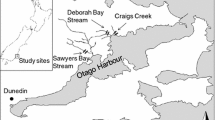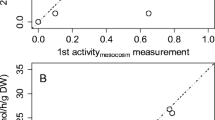Abstract
When animals compete for resources, their competitive abilities and behavioural strategies can be expressed as changes in movement activity. Stress is an important predictor of activity, and the variability of this predictor reflects the impact of environmental and social factors, while the effects of stress are further influenced through individual behavioural syndromes. We examined the effects of social (familiar vs. unfamiliar and resident vs. intruder) and environmental (resource availability) factors and individual characteristics (body mass) on the movement activity of juvenile European catfish Silurus glanis (L.). Familiarity and prior residency decreased the movement activity of these catfish, whereas resource unavailability significantly increased the movement activity of intruders to a level 1.5 times greater than that of the residents. The occurrence of an interaction involving an individual whose body mass was higher than that of individuals from the opposite group predicted a low level of movement activity of this individual. These results suggest that familiarity, prior residency, and high body mass decrease stress from the limited availability of resources.


Similar content being viewed by others

References
Alanärä A, Burns MD, Metcalfe NB (2001) Intraspecific resource partitioning in brown trout: the temporal distribution of foraging is determined by social rank. J Anim Ecol 70:980–986
Benito J, Benejam L, Zamora L, García-Berthou E (2015) Diel cycle and effects of water flow on activity and use of depth by common carp. Trans Am Fish Soc 144:491–501. doi:10.1080/00028487.2015.1017656
Booksmythe I, Jennions MD, Backwell PRY (2010) Investigating the ‘dear enemy’ phenomenon in the territory defence of the fiddler crab, Uca mjoebergi. Anim Behav 79:419–423
Boulêtreau S, Cucherousset J, Villéger S, Masson R, Santoul F (2011) Colossal aggregations of giant alien freshwater fish as a potential biogeochemical hotspot. PLoS ONE 6:e25732. doi:10.1371/journal.pone.0025732
Brännäs E (2008) Temporal resource partitioning varies with individual competitive ability: a test with Arctic charr Salvenius alpinus visiting a feeding site from a refuge. J Fish Biol 73:524–535. doi:10.1111/j.1095-8649.200801941.x
Brodin T (2008) Behavioral syndrome over the boundaries of life—carryovers from larvae to adult damselfly. Behav Ecol 20:30–37. doi:10.1093/beheco/arn111
Brodin T, Johansson F (2004) Conflicting selection pressures on the growth/predation risk trade-off in a damselfly. Ecology 85:2927–2932
Brodin T, Mikolajewski DJ, Johansson F (2006) Behavioral and life history effects of predator diet cues during ontogeny in damselfly larvae. Oecologia 148:162–169
Brown C, Jones F, Braithwaite VA (2007) Correlation between boldness and body mass in natural populations of the poeciliid Brachyrhaphis episcopi. J Fish Biol 71:1590–1601
Burnham KP, Anderson DR (1998) Model selection and inference: a practical information—theoretic approach. Springer, New York
Carter AJ, Feeney WE, Marshall HH, Cowlishaw G, Heinsohn R (2013) Animal personality: what are behavioural ecologists measuring? Biol Rev 88:465–475
Conrad JL, Weinersmith KL, Brodin T, Saltz JB, Sih A (2011) Behavioural syndromes in fishes: a review with implications for ekology and fisheries management. J Fish Biol 78:395–435
Copp GH, Britton JR, Cucherousset J, García-Berthou E, Kirk R, Peeler E, Stakėnas S (2009) Voracious invader or benign feline? A review of the environmental biology of European catfish Silurus glanis in its native and introduced ranges. Fish Fish 10:252–282. doi:10.1111/j.1467-2979.2008.00321.x
Cote J, Clobert J, Brodin T, Fogarty S, Sih A (2010) Personality-dependent dispersal: characteriyation, ontogeny and consequences for spatially structured populations. Philos Trans R Soc Lond B 365:4065–4076. doi:10.1098/rstb.2010.0176
Cote J, Fogarty S, Tymen B, Sih A, Brodin T (2015) Personality-dependent dispersal cancelled under predation risk. Proc R Soc Lond B 280:20132349. doi:10.1098/rspb.2013.2349
Dahlbom SJ, Lagman D, Lundstedt-Enkel K, Sundström LF, Winberg S (2011) Boldness predicts social status in zebrafish (Danio rerio). PLoS ONE 6(8):e23565. doi:10.1371/journal.pone.0023565
David BO, Closs GP, Crow SK, Hansen EA (2007) Is diel activity determined by social rank in a drift-feeding stream fish dominance hierarchy. Anim Behav 74:259–263. doi:10.1016/j.anbehav.2006.08.015
Farwel M, McLaughlin RL (2009) Alternative foraging tactics and risk taking in brook charr (Salvenius fontinalis). Behav Ecol 20:913–921. doi:10.1093/beheco/arp059
Ford JR, Swearer SE (2013) Two’s company, three’s a crowd: food and shelter limitation outweigh the benefits of group living in a shoaling fish. Ecology 94:1069–1077
Gherardi F (2006) Fighting behavior in hermit crabs: the combined effect of resource-holding potential and resource value in Pagurus longicarpus. Behav Ecol Sociobiol 59:500–510
Giraldeau L-A, Caraco T (2000) Social foraging theory. Monographs in behavior and ecology. Princeton University Press, Princeton
Gómez-Laplaza LM, Morgan E (2003) The influence of social rank in the angelfish, Pterophyllum scalare, on locomotor and feeding activities in a novel environment. Lab Anim 37:108–120
Griffiths SW, Ward A (2011) Social recognition of conspecifics. In: Brown C, Laland K, Krause J (eds) Fish cognition and behavior, 2nd edn. Blackwell, Oxford, pp 186–216
Griffiths SW, Broskmark S, Höjesjö J, Jonsson JI (2004) Coping with divided attention: the advantage of familiarity. Proc R Soc Lond B 271:695–699
Höjesjö J, Jonsson JI, Petersson E, Järvi T (1998) The importance of being familiar: individual recognition and social behavior in sea trout (Salmo trutta). Behav Ecol 9:445–451
Humphries EL, Hebblethwaite AJ, Batchelor TP, Hardy IC (2006) The importance of valuing resources: host weight and contender age as determinants of parasitoid wasp contest outcomes. Anim Behav 72:891–898
Kokko H, López-Sepulcre A, Morell LJ (2006) From hawks and doves to self-consistent games of territorial behavior. Am Nat 167:901–912
Koolhaas JM, Korte SM, De Boer SF, van der Vegt BJ, van Reenen CG, Hopster H, de Jong IC, Ruis MAW, Blokuis HJ (1999) Coping styles in animals: current status in behavior and stress–physiology. Neurosci Biobehav R 23:925–935
Liebgold EB, Dibble CJ (2011) Better the devil you know: familiarity affects foraging activity of red-backed salamanders, Plethodon cinereus. Anim Behav 82:1059–1066
MacArthur RH, Pianka ER (1966) On optimal use of a patchy environment. Am Nat 100:603–609
McLaughlin RL, Grant JWA, Kramer DL (1992) Individual variation and alternative patterns of foraging movements in recently-emerged brook charr, Salvelinus fontinalis. Behaviour 120:286–301
Metcalfe NB, Fraser NHC, Burns MD (1999) Food availability and the nocturnal vs. diurnal foraging trade-off in juvenile salmon. J Anim Ecol 68:371–381
Murdoch WW (1994) Population regulation in theory and practice. Ecology 75:271–287
Nakano S (1995) Individual differences in resource use, growth and emigration under influence of a dominance hierarchy in fluvial red-spotted masu salmon in a natural habitat. J Anim Ecol 64:75–84
Olsson O, Bruun M, Smith H (2002) Starling foraging success in relation to agricultural land-use. Ecography 25:363–371
Osenberg CW, St Mary CM, Schmitt RJ, Holbrook SJ, Chesson P, Byrne B (2002) Rethinking ecological inference: density dependence in reef fishes. Ecol Lett 5:715–721
Øverli Ø, Winberg S, Pottinger TG (2005) Behavioral and neuroendocrine correlates of selection for stress responsiveness in rainbow trout—a review. Integ Compar Biol 45:463–474. doi:10.1093/icb/45.3.463
Réale D, Reader SM, Sol D, McDougall PT, Dingemanse NJ (2007) Integrating animal temperament within ecology and evolution. Biol Rev 82:291–318
Rosell F, Gundersen G, Le Galliard J-F (2008) Territory ownership and familiarity status affect how much male root voles (Microtus oeconomus) invest in territory defence. Behav Ecol Sociobiol 62:1559–1568
Rudolf V (2007) Consequences of stage-structured predators: cannibalism, behavioral effects, and trophic cascades. Ecology 88:2991–3003
Sih A, Kats LB, Maurer EF (2003) Behavioural correlations across situations and the evolution of antipredator behavior in a sunfish–salamandre system. Anim Behav 65:29–44
Sih A, Bell A, Johnson JC (2004) Behavioral syndromes: an ecological and evolutionary overview. Trends Ecol Evol 19:372–378
Sih A, Cote J, Evans M, Fogarty S, Pruitt J (2012) Ecological implications of behavioural syndromes. Ecol Lett 15:278–289. doi:10.1111/j.1461-0248.2011.01731.x
Sikkel PC, Kramer DL (2005) Territory revisits reduce intrusion during spawning trips by female yellowtail damselfish, Microspathodon chrysurus. Anim Behav 71:71–78. doi:10.1016/j.anbehav.2005.03.028
Slavík O, Horký P (2012) Diel dualism in the energy consumption of the European catfish Silurus glanis. J Fish Biol 81:2223–2234
Slavík O, Horký P, Bartoš L, Kolářová J, Randák T (2007) Diurnal and seasonal behaviour of adult and juvenile European catfish as determined by radio-telemetry in the River Berounka, Czech Republic. J Fish Biol 71:104–114. doi:10.1111/j.1095-8649.2007.01471.x
Slavík O, Pešta M, Horký P (2011) Effect of grading on energy consumption in European catfish Silurus glanis. Aquaculture 313:73–78
Slavík O, Maciak M, Horký P (2012) Shelter use of familiar and unfamiliar groups of juvenile European catfish Silurus glanis. Appl Anim Behav Sci 142:116–123
Stokkebo S, Hardy ICW (2000) The importance of being gravid: egg load and contest outcome in a parasitoid wasp. Anim Behav 47:339–350
Sultana Z, Takaoka J, Koga T (2013) Resource value differentially affects fighting success between reproductive and non-reproductive seasons. J Ethol 31:203–209
Takeuschi T (2006) Matter of size or matter of residency experience? Territorial contest in a Green hairstreak, Chrysoyephyrus smaragdinus (Lepidoptera: Lycaenidae). Ethology 112:293–299
Turchin P (1999) Population regulation: a synthetic view. Oikos 84:153–159
Valdimarsson SK, Metcalfe NB, Thorpe JE, Huntingford FA (1997) Seasonal changes in sheltering: effects of light and temperature on diel activity in juvenile salmon. Anim Behav 54:1405–1412
Werner EE, Anholt BR (1993) Ecological consequences of the trade-off between growth and mortality rates mediated by foraging activity. Am Nat 142:242–272
Wilson ADM, McLaughlin RL (2007) Behavioral syndromes in brook charr, Salvelinus fontinalis: prey-search in the field corresponds with space use in novel laboratory situations. Anim Behav 74:689–698
Wolf M, van Doorn S, Leimar O, Weissing FJ (2007) Life-history trade-offs favour the evolution of animal personalities. Nature 447:581–585
Acknowledgments
This work was supported by the Czech Science Foundation (No. 13-05872S). The authors sincerely thank anonymous referees for critical evaluation and valuable comments on the manuscript. In addition, the authors wish to thank M. Fort for his assistance during the experimental period, and A. Slavikova for the help with earlier versions of the manuscript.
Author information
Authors and Affiliations
Corresponding author
About this article
Cite this article
Slavík, O., Horký, P., Maciak, M. et al. Familiarity, prior residency, resource availability and body mass as predictors of the movement activity of the European catfish. J Ethol 34, 23–30 (2016). https://doi.org/10.1007/s10164-015-0441-9
Received:
Accepted:
Published:
Issue Date:
DOI: https://doi.org/10.1007/s10164-015-0441-9



